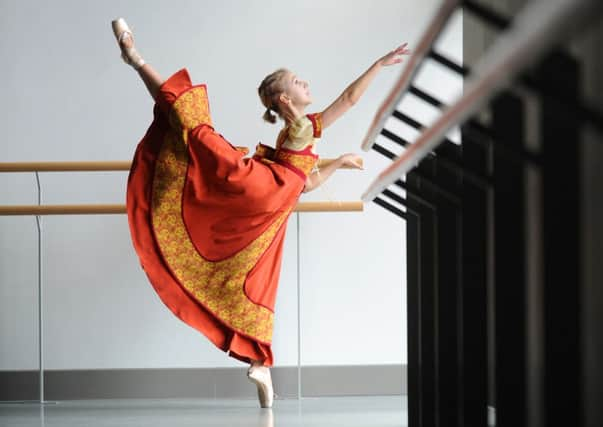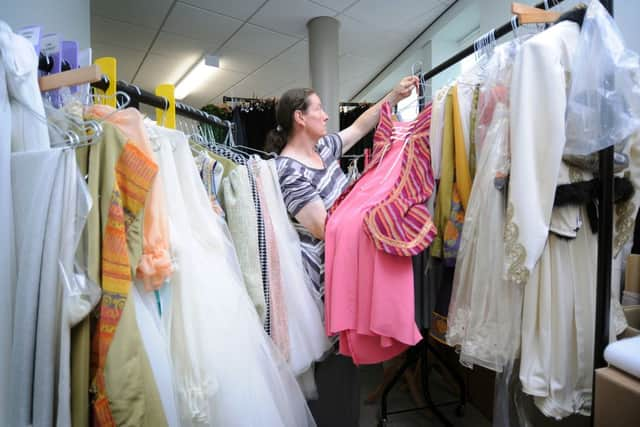A costume drama


WHEN David Nixon was barely out of nappies, his older sisters would take him with them when they went shopping for clothes near the family home in Chatham, Ontario.
Those forays into town for party dresses, a knee-high view of a world of colour, mirrors, and the way garments related to the female form, gave him an early appreciation of fabric and design which was to influence very strongly his whole artistic ethos.
Advertisement
Hide AdAdvertisement
Hide AdLater, after he had trained as a dancer and moved on to the National Ballet of Canada and then the Deutsch Oper Ballet in Berlin as principal dancer, strong feelings about the interplay between dance and the clothes dancers wore began to surface.


“I became aware of costumes in relation to what I was having to do, movement-wise, and because I was quite high up in the company I could ask questions like ‘Do you know what I have to do in this costume?’ The designer would say: ‘No, not at all.’ I told them they’d made a costume I couldn’t move in, yet the movement in the ballet needed to be very plastic, very fluid.
“From that point I began to influence how things were done. It’s not just about looking good – although dancers do stand straighter and move more confidently when they know they look good – but about what the costume does to the movement.”
Today, as artistic director of the multi-award-winning Leeds-based Northern Ballet (he’s been there 12 years now), he is both choreographer and – highly unusually – costume designer.
Advertisement
Hide AdAdvertisement
Hide AdThe impressive list of new productions he has added to the repertoire includes the hugely popular Madame Butterfly, Wuthering Heights, Swan Lake, A Midsummer Night’s Dream, Dracula, Hamlet, Cleopatra and Beauty and the Beast.
His starting point for each one, before any other consideration, is how the characters will look.
“As a dancer I always had a clearer image of what I should be wearing than the designer had.
“I can see in my mind’s eye what a character’s clothes will look like, the fabric they will wear... and then I get an idea of what the steps should be.
Advertisement
Hide AdAdvertisement
Hide Ad“But it isn’t until I see something made up and on a dancer’s body that I get the definitive idea of what they will do in that costume. It’s absolutely crucial to me.”
An intense artistic vision of a look, a feel and a style dictated by costume is one thing; bringing it to glorious life, while ensuring that the dancers feel it allows them to tell the story comfortably and without self-consciousness or fear of malfunction is another.
Northern Ballet has a small in-house wardrobe department that works wonders. A handful of staff look after costumes on tour, and a small team carry on at HQ, crafting many dozens of costumes for each new production, working within a tight budget. Costume takes up 50 per cent of the spend on staging any new work.
In the case of the recent smash hit The Great Gatsby, the wardrobe budget was £85,000 and had to provide costumes for second, third and fourth casts who would be touring the show around the UK. Hundreds of pairs of shoes and pants are included and customised to each dancer.
Advertisement
Hide AdAdvertisement
Hide AdCostume design assistant Julie Anderson, working closely with head of wardrobe Kim Brassley and a small team, takes Nixon’s vision and works it into magical reality.
The two have worked together for enough years to have placed complete trust in each other’s judgement, and in Anderson (whose credits include costume work in films with Steven Spielberg and Disney) he has found someone perfectly attuned to the need of ballet costumes to create illusion and enchantment while allowing a dancer’s body to do its work.
It may not sound romantic, but the bottom line for her is that “…costume is a uniform that a dancer needs to do their job.”
That said, the continual challenges of clothing dancers for a ball scene in Cinderella, the Art Deco-influenced glitz of Gatsby’s Daisy as wells as the contrasting, down-to-earth style of Myrtle and the athletic Jordan in the same piece, or the lighter-than-air costumes of Nixon’s startling Cleopatra, certainly seem to stir Anderson’s juices.
Advertisement
Hide AdAdvertisement
Hide Ad“I really do love my job, even the less good days are pretty good,” she says.
“Each of Daisy’s costumes took a week to make, and she had four dresses and we had four casts. So it took 16 weeks to make just those costumes. In all we made around 160 costumes. We have to make more costumes than companies that are more generic in the size and shape of their dancers. Our casts can’t really share costumes, as they are different heights and shapes, because we go for individuality.”
All this means that work starts on costumes up to nine months before a ballet premieres.
Anderson explains that decisions are made early on about where the biggest portions of costume budget will go. “People will expect a ball scene to be sumptuous but there are other scenes involving some dancers in plainer costumes, where you can get away with cheaper fabrics but many layers. Adding a slightly shimmering fabric just below the top layer catches the light.”
Advertisement
Hide AdAdvertisement
Hide AdNixon is wont to walk into work with a bag full of some divine and very expensive silk he has found at a favourite fabric store.
“He has a phenomenal gift for finding the right fabric and knows how it will work on a dancer,” says Anderson. “It’s a great situation for me when he gives me a bag of beautiful white chiffon and says ‘Here, see what you can do with that.’
“I know what he likes – and that particular fabric was for the nightdress in Swan Lake – so I set to work on something that showed the bodyline, had a corseted top, was stretchy where it needed to be, with a skirt that did amazing things.”
“But, much as David loves finding something sumptuous, he does allow us to drag him off to Leeds Market, where we often find other fabrics that are absolutely perfect.”
Advertisement
Hide AdAdvertisement
Hide AdBeing a former dancer, Nixon knows first-hand the requirements of costume. A pas de deux cannot be hampered by a dress riding up, ripping or being so embellished in the wrong places that it will cause injury to the dancers or shred the garment itself.
“When a boy is partnering, the girl’s dress has to work in a certain way: it can’t just slip up in his hands or have beads or sequins in vital places. Hence embellishments are often around the neck, on the back or around the hem, with plain panels at the waist and sides.”
The master’s vision naturally allows for input from the cast. “They pop in to the wardrobe department all the time to see how things are coming along.
“They like light costumes, but we did beautiful designs for Hook in Peter Pan that included heavy Louis XIV sleeves on the coat and big trousers.
Advertisement
Hide AdAdvertisement
Hide Ad“Once the dancers tried the costume, they said they liked how they looked – and the look is crucial with Hook – but it was all very heavy. So we had to take out half the choreography because they couldn’t physically sustain so much dancing in those heavy clothes. At other times you change the costume and keep the choreography.”
Cinderella opens next month, and is loosely set in Imperial Russia. Costume-wise, Nixon and Anderson have gone for heavily embroidered (and expensive) bodices, with chiffon, danceable skirts. A brief glimpse testifies that the effect will be stunning.
The most revealing costumes so far in Nixon’s portfolio were those tiny, fine and completely arresting scraps of silk that adorned Martha Leebolt as Cleopatra. She was at all times sinuous and iridescently sexy – a true ‘Serpent of Old Nile’.
“Martha has an exquisite and very athletic physique,” he says. “So I said to her ‘It’s all off’, we will look at everything we can – it will be all about your body. In actual fact, most of the time the women of Ancient Egypt were topless or naked beneath a sheer fabric. The Romans’ eyes were popping out.
Advertisement
Hide AdAdvertisement
Hide Ad“Men only wore a small skirt wrap. I wanted to recreate that effect, and see the working of the body very clearly. ”
Sometimes Nixon and Anderson disagree. “Yes, he’ll occasionally say ‘Actually, I don’t like that…’ but usually we achieve what we both want,” she says.
He adds: “You can draw as beautiful a costume as you like, but if the person putting it together can’t realise that dream then it’s pointless. What’s been brilliant here is that Julie’s able to bring them to life, often in a better way than expected.”
David Nixon says the downside of wearing so many hats is that anxiety about what comes next mean you can easily forget to enjoy the present.
Advertisement
Hide AdAdvertisement
Hide Ad“We recently took Gatsby to London and it had sold out beforehand, which was a first. I told myself I must enjoy that week and savour every moment, because it’s a terrible thing not to enjoy the here and now.”
Northern Ballet’s Cinderella is at Leeds Grand Theatre December 17 to January 4 and at Hull New Theatre April 2-5, 2014. Three Little Pigs is on tour and venues include Leeds, Bradford, Harrogate and Huddersfield. Christmas Carol Excerpts is at Bradford Alhambra Theatre from November 13 to 16. A Midsummer Night’s Dream returns from a tour of China and resumes its UK tour early next year. 0113 220 8000 or www.northern ballet.com.